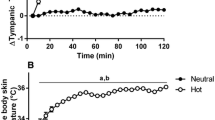Abstract
Immersion in high concentrations of CO2 dissolved in freshwater (CO2-water) might induce peripheral vasodilatation in humans. In this study, we investigated whether such immersion could affect the autonomic nervous system in humans using spectral analysis of heart rate variability. Ten healthy men participated in this study. Tympanic temperature, cutaneous blood flow and electrocardiogram (ECG) were measured continuously during 20 min of immersion in CO2-water. The ECG was analyzed by spectral analysis of R–R intervals using the maximal entropy method. The decrease in tympanic temperature was significantly greater in CO2-water immersion than in freshwater immersion. Cutaneous blood flow at the immersed site was significantly increased with CO2-water immersion compared to freshwater. The high frequency component (HF: 0.15–0.40 Hz) was significantly higher in CO2-water immersion than in freshwater immersion, but the low frequency (LF: 0.04–0.15 Hz) /high frequency ratio (LF/HF ratio) was significantly lower in CO2-water immersion than in freshwater immersion. The present study contributes evidence supporting the hypothesis that CO2-water immersion activates parasympathetic nerve activity in humans.







Similar content being viewed by others
References
Akselrod S, Gordon D, Ubel FA, Shannon DC, Berger AC, Cohen RJ (1981) Power spectrum analysis of heart rate fluctuation: a quantitative probe of beat-to-beat cardiovascular control. Science 213(4504):220–222 doi:10.1126/science.6166045
Armour JA, Hageman GR, Randall WC (1972) Arrhythmias induced by local cardiac nerve stimulation. Am J Physiol 223(5):1068–1075
Bolter CP, Atkinson KJ (1988) Influence of temperature and adrenergic stimulation on rat sinoatrial frequency. Am J Physiol 254(5 Pt 2):R840–R844
Choukroun ML, Kays C, Varène P (1989) Effects of water temperature on pulmonary volumes in immersed human subjects. Respir Physiol 75(3):255–265 doi:10.1016/0034-5687(89)90036-4
Dodt E (1956) Die aktivität der thermoreceptoren bei nichtthermischen reizen bekannter thermoregulatorischer wirkung. Pflugers Arch 263:188–200 doi:10.1007/BF00362907
Doubt TJ, Mayers DL, Flynn ET (1987) Transient cardiac sinus dysrhythmia occurring after cold water immersion. Am J Cardiol 59(15):1421–1422 doi:10.1016/0002-9149(87)90934-9
Fleisher LA, Frank SM, Sessler DI, Cheng C, Matsukawa T, Vannier CA (1996) Thermoregulation and heart rate variability. Clin Sci (Lond) 90(2):97–103
Hashimoto M, Yamamoto N (2004) Decrease in heart rates by artificial CO2 hot spring bathing is inhibited by β1-adrenoceptor blockade in anesthetized rats. J Appl Physiol 96:226–232 doi:10.1152/japplphysiol.00812.2003
Hupka J (1975) Ballistocardiographic changes after carbon dioxide baths. Bibl Cardiol (33):113–116
Ito T, Moore JI, Koss MC (1989) Topical application of CO2 increases skin blood flow. J Invest Dermatol 93:259–262 doi:10.1111/1523-1747.ep12277584
Itoh M, Fukuoka Y, Kojima S, Araki H, Hotta N, Sakamoto T et al (2007) Comparison of cardiovascular autonomic responses in elderly and young males during head-out water immersion. J Cardiol 49(5):241–250
Matsumura K, Nakayama T, Kaminaga T (1987) Effects of carbon dioxide on preoptic thermosensitive neurons in vitro. Pflugers Arch 408(2):120–123 doi:10.1007/BF00581339
Myers RW, Pearlman AS, Hyman RM, Goldstein RA, Kent KM, Goldstein RE et al (1974) Beneficial effects of vagal stimulation and bradycardia during experimental acute myocardial ischemia. Circulation 49(5):943–947
Mourot L, Bouhaddi M, Gandelin E, Cappelle S, Dumoulin G, Wolf JP et al (2008) Cardiovascular autonomic control during short-term thermoneutral and cool head-out immersion. Aviat Space Environ Med 79(1):14–20 doi:10.3357/ASEM.2147.2008
Nishimura N, Sugenoya J, Matsumoto T, Kato M, Sakakibara H, Nishiyama T et al (2002) Effects of repeated carbon dioxide-rich water bathing on core temperature, cutaneous blood flow and thermal sensation. Eur J Appl Physiol 87:337–342 doi:10.1007/s00421-002-0626-0
Perini R, Milesi S, Biancardi L, Pendergast DR, Veicsteinas A (1998) Heart rate variability in exercising humans: effect of water immersion. Eur J Appl Physiol Occup Physiol 77(4):326–332 doi:10.1007/s004210050341
Pomeranz B, Macaulay RJ, Caudill MA, Kutz I, Adam D, Gordon D et al (1985) Assessment of autonomic function in humans by heart rate spectral analysis. Am J Physiol 248(1 Pt 2):H151–H153
Reed MJ, Robertson CE, Addison PS (2005) Heart rate variability measurements and the prediction of ventricular arrhythmias. Q J Med 98(2):87–95
Schipke JD, Pelzer M (2001) Effect of immersion, submersion, and scuba diving on heart rate variability. Br J Sports Med 35(3):174–180 doi:10.1136/bjsm.35.3.174
Task Force of the European Society of Cardiology and the North American Society of Pacing and Electrophysiology (1996) Heart rate variability: standards of measurement, physiological interpretation and clinical use. Circulation 93:1043–1065
Yasuma F, Hayano J (2004) Respiratory sinus arrhythmia: why does the heartbeat synchronize with respiratory rhythm? Chest 125(2):683–690 doi:10.1378/chest.125.2.683
Author information
Authors and Affiliations
Corresponding author
Rights and permissions
About this article
Cite this article
Sato, M., Kanikowska, D., Iwase, S. et al. Effects of immersion in water containing high concentrations of CO2 (CO2-water) at thermoneutral on thermoregulation and heart rate variability in humans. Int J Biometeorol 53, 25–30 (2009). https://doi.org/10.1007/s00484-008-0188-x
Received:
Revised:
Accepted:
Published:
Issue Date:
DOI: https://doi.org/10.1007/s00484-008-0188-x




